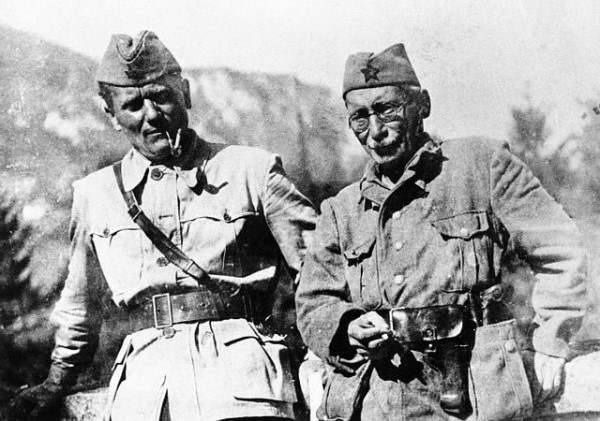Moša Pijade (Serbian Cyrillic: Мoшa Пијаде, alt. Eng. transliteration Moshe Piade; 4 January 1890 – 15 March 1957), nicknamed Čiča Janko (Чича Јанко, lit. “Old Man Janko”) was a Serbian and Yugoslav communist, a close collaborator of Josip Broz Tito, Yugoslav politician, and full member of the Serbian Academy of Sciences and Arts.
Pijade was of Sephardic Jewish (from Spain) parentage. In his youth, Pijade was a painter, art critic and publicist. He was also known for translating Das Kapital by Karl Marx into Serbo-Croatian.
He is thought to have had a major influence on Marxist ideology as exposed during the old regime in the Kingdom of Yugoslavia. In 1925, he was sentenced to 20 years in prison because of his ‘revolutionary activities’ after World War I. He was discharged after 14 years in 1939 and imprisoned again in 1941 in the camp Bileća.
During the World War Two, Pijade was one of the leaders of the Uprising in Montenegro. His ruthless cruelty toward the people who refused to join his units was noted. He was subsequently recalled to the communist headquarters because of the issues connected to the uprising. Under the influence of Pijade and Milovan Đilas an extreme prosecution of “leftist errors” was pursued by the Partisans in Montenegro.
In March 1942, Pijade met British envoy in occupied Yugoslavia Terence Atherton and took him on a tour of inspection of the organization of the communist forces in Žabljak.
Pijade was known as the creator of the so-called ‘Foča regulations’ (1942), which prescribed the foundation and activity of people’s liberation committees in the liberated territories during the war against the Nazis. In November 1943, before the second AVNOJ meeting in Jajce, he initiated the foundation of Tanjug, which later became the state news agency of SFR Yugoslavia, nowadays of Serbia.
Pijade held high political posts during and after World War II and was a member of the Central Committee and the Politburo of the Communist Party of Yugoslavia. He was one of the leaders of Tito’s partisans and was subsequently proclaimed People’s Hero of Yugoslavia. He was one of six Vice Presidents of the Presidium of the Yugoslavian Parliament (deputy head of state) 1945–53.
In 1948 Pijade convinced Tito to allow those Jews who remained in Yugoslavia to emigrate to Israel. Tito agreed on a one-time exception basis. As a result, 3,000 Jews emigrated from Yugoslavia to Israel on the SS Kefalos in December 1948. Among those was Tommy Lapid, who became Deputy Prime Minister of Israel and was the father of Yair Lapid.
After having led the law commission of the Parliament, Pijade was Vice-President (1953–54) and President of the Yugoslavian Parliament or Skupština (1954–55). In 1957, he died in Paris during the return from a visit to London, where he had talks as leader of a Yugoslav parliamentary delegation. Streets in many cities of the former Yugoslav countries were once named after him.
After finishing primary school, he left the Lower Gymnasium in 1905, when he attended the Art and Craft School in Belgrade with Marko Murat for a short time, and immediately after that he became a private student of Paško Vučetić. Studied 1906-1907. painting in Munich at the private school of Heinrich Knir and then at the Academy of Fine Arts with the painter Angel Janko. He went to Paris in 1909 and returned to Belgrade in 1910.
From 1913 to 1914 he was a drawing teacher at the Gymnasium in Ohrid, Macedonia.
He exhibited for the first time in Sombor in 1911, then in 1919 with the “Group of Artists” in Belgrade. He organized the only solo exhibition in 1952 in his studio in Belgrade. Commemorative exhibitions were organized for him in 1957 and 1958 in Belgrade, Sarajevo, Pula, Zagreb, Ljubljana and Split.
Moshe Pijade’s painting concept is based on nature, form and light. Although modernist, Pijade remained consistent with the realistic form until the end of his career. Historiography divided his painting into three periods: I – dark 1910-1924, II – prison 1925-1939. and III – bright 1939—1957.
He made about 120 paintings (most of which have been lost) and hundreds of sketches and drawings. The most valuable paintings are in the National Museum and the Museum of Contemporary Art in Belgrade.
Information is taken from:
